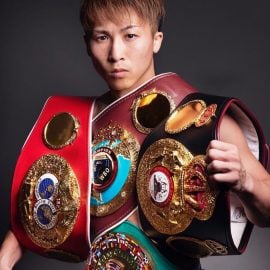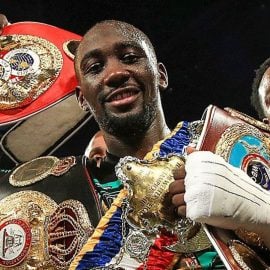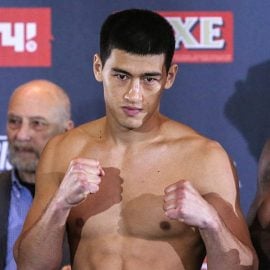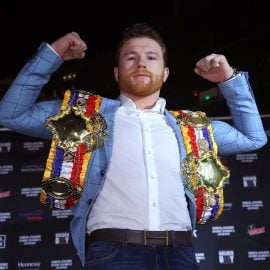‘Fighting Words’ — Once Again the Underdog, Just How Caleb Truax Likes It
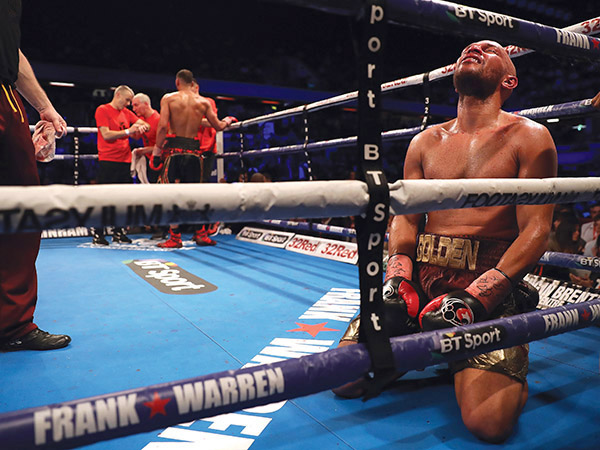
Caleb Truax isn’t the one defending his super middleweight world title later this month. He isn’t the undefeated boxer who’s being talked about for a big unification match with Canelo Alvarez. He isn’t the younger man, the fresher fighter, the one who is favored to win.
Truax will be the underdog when he challenges Caleb Plant in the main event of a Fox broadcast on Jan. 30 in Los Angeles. He is comfortable with that label. He’s worn it several times before.
“I’ve always embraced that role,” Truax told me earlier this month. “It motivates me to outwork the people I’m in the ring with. That’s what I’ve had to do to make up for the lack of experience and the lack of time I’ve had in the sport of boxing. The same thing applies to this next fight.”
Truax was a late starter. He didn’t grow up in boxing gyms as a kid. He didn’t spend his teen years making his way through the unpaid ranks. He put on a pair of boxing gloves when he was 19 — an age when the best young fighters are competing for amateur championships, trying out for Olympic teams, or even going pro. Truax? He entered a Toughman Contest. And he lost.
But Truax has become a late bloomer. There was a brief amateur career and then a long apprenticeship. He was a working-class fighter who became a local headliner in his native Minnesota. He suffered three defeats before winning his first world title. He was 34 at the time, past the age when most fighters are considered in their prime. He’s 37 now, older than anyone else in The Ring’s rankings of the top super middleweights in the world.
“It’s pretty wild,” said Truax, who is 31-4-2 with 19 knockouts. “I never really expected to get to where I’m at. I was doing it because I was having fun and love the sport of boxing. I never expected to fight in three world title fights. This will be my fourth.”
This will be Plant’s fourth world title fight as well. He’s 28, nine years younger than Truax. His record is unblemished, 20-0 with 12 KOs. He outpointed Jose Uzcategui two years ago to win the International Boxing Federation title — the same belt Truax once owned — and defended it since with a pair of knockouts, putting away Mike Lee in three rounds and Vincent Feigenbutz in 10.
“I’ve seen quite a few of his fights,” Truax said of Plant. “I think he’s got good hand speed, good foot speed, good balance and throws good combinations. And he’s got a high ring IQ.
“When he fought Uzcategui, I thought he started the fight pretty well. He knocked him down twice. Nobody thought he was going to do that. I thought he faded when Uzcategui started fighting late and putting pressure on him. Those last two fights, I don’t really take much stock in those. Mike Lee had no business even being in there with him. I’d never even seen the other guy [Feigenbutz] fight.”
Even though Plant is nine years younger than Truax, he’s actually been fighting longer. Plant was in elementary school when he began kickboxing — a little bit before college-aged Truax competed in Toughman. Plant soon transitioned to boxing and had 117 amateur matches, far more than Truax. He won a national Golden Gloves championship in 2011 and was an alternate for the United States 2012 Olympic boxing team.
Truax isn’t daunted by the prospect of sharing the ring with a talented opponent. He’s been doing that for years.
There was Truax’s first pro defeat, against former middleweight champ Jermain Taylor in 2012. It was a big step up at the time for Truax, even if Taylor had lost four of his previous six fights. Truax lost a wide decision, though he did drop Taylor late in the bout with a one-two combination.
“I was even more confident after that fight, even though I lost, than I was before,” Truax told me in 2013, some 14 months after the Taylor fight. “I knew that going in that I was a talented fighter. But after that, I kind of knew that I belonged with the main guys in the division.
“I started late in boxing. I didn’t have a lot of an amateur career. I don’t want to say there were doubts in my mind that I belonged, but I just didn’t know where I fit in, just where I was as far as talent and experience and all of that,” he said at the time. “I think that’s kind of solidified for me, made something click in my head, like this is for real now, man. I belong with the best. I can be with the best. I just have to make a couple changes and improve.”
Looking back, Truax sees the aftermath of that Taylor fight as the turning point for how he approached things in the ring.
“Back then, I was more of a counter-puncher. I was kind of waiting for stuff to come to me. That’s kind of my personality, just low-key and laid back,” Truax said in our recent interview. “After that fight, I and my coach realized that in order to beat a guy that’s top-level, you can’t sit back and wait. You have to be aggressive. If you want to be a counter-puncher, you have to be an aggressive counter-puncher.
“That turned me more into a pressure fighter,” he said. “And using my work ethic and my conditioning to my advantage by pushing the other guy. And my physical strength. I’m pretty strong.”
There were further developmental fights, necessary as Truax transformed his style, but also because he was otherwise a prospect when he fought Taylor. He needed more seasoning, still learning on the job, making adjustments after every fight.
“I’ve grown by leaps and bounds,” Truax told me in 2014.

Photo by Steven Paston – Getty Images
By then, he’d signed with influential boxing adviser Al Haymon. That helped lead to some big fights. Truax got his first world title shot in 2015, taking on Daniel Jacobs for the World Boxing Association’s “regular” belt at 160 pounds. Jacobs stopped Truax in the 12th round. Truax had another major opportunity a year later, facing former titleholder Anthony Dirrell at super middleweight in April 2016.
The Dirrell bout ended much more quickly. Truax was hurt halfway into the first round, dropped twice for the TKO.
“I wasn’t myself,” Truax said. “My girlfriend had just recently given birth to my daughter and had severe complications. She almost died in childbirth. Going into that fight, I wasn’t in the mental spot I needed to be in. I should’ve never taken that fight. I remember going to Atlantic City and basically having a panic attack: ‘What if I can’t take care of my daughter? What if I get hurt?’”
Truax’s girlfriend has since recovered. Their daughter is nearly 5 years old. Their son is a year and a half.
“Being a father changed my outlook on life. And in turn it changed my outlook on boxing, where my motivation lies,” he said. “Before I had kids, it was me strictly being a competitive person, an overly competitive person, never wanting to lose. There’s still that in play. Now it’s providing for my family as well. That provides an extra layer of motivation to get the job done and take care of my kids.”
I remember being worried about Truax after the Dirrell fight, concerned that maybe the move to super middleweight was too much for him.
It’s cliché to say that adversity can make a person stronger. It’s also true. For some fighters, defeat is a sign that they’ve hit their ceiling, that their limits have been exposed, that they’re capable of fighting up to a certain level, but not quite beyond it. Truax can never go back in time and get the experience that his opponents have. He may never match their speed or boxing ability. But he tries to make up for that.
“Basically, it boils down to hard work,” he said. “I hate losing. I think that’s the thing that got me to where I’m at today, is I’ve always learned from my losses. I’ve always reassessed what I did wrong. Even in wins, I assess what went right and what went wrong. I just try to learn and work hard. I’ve always had that frame of mind where I started late and I needed to outwork people who started before me and had more experience.”
That’s exactly what Truax did in December 2017, when he traveled into hostile territory, going to London to face James DeGale, the world titleholder who had started boxing at 10 years old, had competed in nearly 100 amateur fights, won gold in the 2008 Olympics, picked up a pro world title by defeating Andre Dirrell, and was making his fourth defense against Truax.
Truax knew what DeGale did well. He knew that he couldn’t fight DeGale’s fight. And so he went to work on outworking DeGale, on making him uncomfortable. Truax threw 280 more punches than DeGale did that night, 733 to 453, according to CompuBox,. He landed twice as many as DeGale, 225 to 113. He pressured DeGale to the ropes and let his hands go, picking up points and winning a majority decision.
Here was the man whose first fight was a Toughman loss, who fought at first for fun rather than dreaming of fame and fortune, who turned pro mainly to help pay off his college debt, and who had finally closed up his student loans just six months before the DeGale fight. Now he had a world title.
It was a huge night for Truax. The past few years, however, haven’t been as celebratory.
Truax and DeGale had a rematch four months later, in April 2018. DeGale, healed up from lingering injuries he said had hampered him in the first fight, performed better the second time around. He utilized his jab, boxed and moved more, had more success staying away from the ropes, and tied up when Truax got close. Truax threw far fewer punches in Las Vegas than he had in London, going 103 of 471, contrasted with 225 of 733.
“I thought I did enough to win the fight, but I also thought I was pretty flat and didn’t get my shots off like I wanted,” Truax said afterward.
He’s only fought three times since. There was a bounce-back win in summer 2018 against a 15-10-1 foe. There was a disappointing, cut-shortened affair against Peter Quillin in April 2019, ruled a “no contest” just two rounds in after a clash of heads opened up a deep cut over Truax’s right eye. A rematch with Quillin, initially set for August 2019, was canceled when Truax hurt his Achilles tendon.
Truax returned in January 2020 against the 16-4-1 David Basajjamivule; he won a majority decision and wasn’t happy with his performance. Truax scheduled another fight for last February. His opponent pulled out. Then a fan-friendly fight with Alfredo Angulo was scheduled for last August. Truax fell ill; Angulo fought someone else instead.
This will be Truax’s first bout in a year. It’s been nearly as long for Plant. But this fight is being marketed as a last stand for Truax — which, true to form, he is using as fuel.
“I’m treating this like my last opportunity to win my title back,” Truax said in a press release.
For Plant, meanwhile, this bout is being positioned as a stepping stone. Plant speaks of being “on a mission to be the first undisputed super middleweight champion in boxing history.” The other titleholders at 168 are Canelo Alvarez and Billy Joe Saunders.
“Everybody’s writing me off like they did in the fight with James DeGale,” Truax said. “All I hear is Canelo vs. Caleb Plant, and Plant vs. this or that. He’s even talking about it. That’s just giving me motivation to go out and prove everybody wrong again.”
And Truax sees a similar strategy for Plant as the one he utilized for DeGale.
“I’m not going to be able to stand in the ring and win a boxing match with James DeGale. I’m not going to be able to outbox Caleb Plant,” Truax said. “I’m going to make him uncomfortable and use what I’m good at — pressure fighting and being a high-IQ guy.
“I’ve always prided myself on being able to out-think everybody I’ve ever fought,” he said. “That’s where my game plan comes into play. Also, the pressure I apply. I don’t think it’s something he’s ever seen before. Just the total package of pressure, ring IQ and conditioning is something he’s never seen before. I think I’m better than any fighter he’s ever faced.”
The 10 Count
1 – First, a correction:
Last week’s column about Demetrius Andrade included this incorrect paragraph: “The fact that DAZN and Matchroom Boxing have worked in recent years with the likes of Canelo, Golovkin and Daniel Jacobs — pairing them against each other, but never against Andrade — reflects the reality that Andrade has created but failed to recognize.”
I had my timeline wrong and failed to do my usual due diligence in that paragraph of double-checking everything I write. The two fights between Canelo Alvarez and Gennadiy Golovkin were in September 2017 and September 2018 and broadcast by HBO’s pay-per-view arm, prior to DAZN’s launch. Matchroom Boxing was not involved. Ditto for Golovkin’s fight with Daniel Jacobs in March 2017. Jacobs signed with Matchroom later on, fought Canelo on DAZN in May 2019, and recently became a free agent.
Thank you to the reader who flagged this. I regret the error.
2 – Speaking of people needlessly messing things up, let’s talk about Sergey Kovalev. Again.
Just three weeks ago, this column looked at the self-destruction of Kovalev — racist remarks, legal issues, defeats that left him in danger of being left behind in the light heavyweight division, and then his biting the hand that feeds him by illegally streaming DAZN’s broadcast of Callum Smith vs. Canelo Alvarez.
Despite all of that, DAZN was going to feature Kovalev on January 30 in a crossroads fight with unbeaten prospect Bektemir Melikuziev.
Not anymore.
Kovalev came up positive for synthetic testosterone under testing overseen by the Voluntary Anti-Doping Association (VADA), according to boxing writer Dan Rafael. The urine sample was collected on Dec. 30. The positive test was announced last week. Kovalev vs. Melikuziev was soon canceled.
Kovalev’s promoter, Kathy Duva of Main Events, released a statement to the media:
“VADA was contracted for this fight at [Kovalev’s] insistence, as he has requested for almost all of his fights going back several years,” Duva said. “He maintains that he did not purposefully ingest any banned substances. We have made arrangements to have his supplements tested for contamination and will request that VADA test his B sample.”
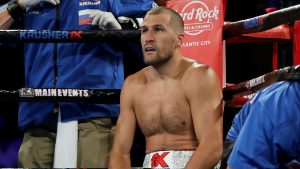
Supplement contamination is a possibility. But in the end, the boxer must be held responsible for what goes in their body. With big fights, big money, and their reputation on the line, they should be doing due diligence before a positive test, not afterward.
Even if this winds up being a case of contaminated supplements, the Melikuziev fight is still off for now. The damage has been done. And there could be further repercussions depending on what happens with the athletic commission’s investigation and hearings.
3 – Boxing fan Michael Hirschbein perfectly summed up Kovalev’s recent situations — beginning with DAZN, ending with VADA — in a post on the enjoyable SN Boxing group on Facebook:
“Two illegal streams in the same month.”
4 – The fight was canceled even though Melikuziev had said he was still willing to face Kovalev.
“It makes no difference to me,” Melikuziev tweeted last week. “Just put him in the ring. Let us fight regardless.”
It’s understandable that Melikuziev would still want to go forward with the match. He’s been training for the fight. Canceling the fight would mean he’d put himself through the sacrifices and punishment for nothing, for no paycheck and no victory on his record. He’s a rising prospect who is 6-0 (5 KOs), who believes he can beat Kovalev and move on to the next step. Canceling this fight means postponing his progress.
(It’s also fair to wonder about Melikuziev’s perspective on performance-enhancing drugs given the fact that Melikuziev was once sanctioned by AIBA for taking banned substances.)
Yet it’s good that Melikuziev’s wishes weren’t respected and that the fight was canceled. Kovalev’s positive test needs to be adjudicated, not brushed aside as a momentary distraction. There needs to be tangible deterrence to hopefully prevent more fighters from doping. Fighters who test positive shouldn’t be allowed to fight. They shouldn’t get paid. And they should be handed lengthy suspensions.
Boxing is still way behind what it should be doing with drug testing. It doesn’t test often enough. It doesn’t punish fighters severely enough. Don’t let the occasional positive test — even if it involves a big name — fool you into thinking otherwise.
5 – Some bad news, even if it’s not at all surprising: James Kirkland wants to keep fighting.
Kirkland was last seen getting knocked down three times in two minutes against Juan Macias Montiel. He showed poor coordination, nonexistent defense, unsteady legs, and a chin that was both highly exposed and highly vulnerable.
To these eyes, it was a sign that age, long layoffs, a hard life, hard training camps and hard fights had taken their toll on the 36-year-old.
To Kirkland, it was merely a reflection of the pandemic affecting the way he normally prepares for a fight.
“The things that we needed, we needed sparring, the type of sparring that we needed, it wasn’t available,” Kirkland told boxing reporter Curran Bhatia in a video interview.
Kirkland said he also had issues with rehydrating, that he didn’t have easy access to his usual methods of getting fluid back in his body, and that this affected everything.
“You don’t rehydrate the right way, your [ability] to adapt or to be able to take a punch or to be able to give it your all, or to be able to land those punches that you need, they’re not going to be there,” he said.
Every name fighter who loses will look for what went wrong. They’ll keep searching for that perfect training camp. It becomes an impossible treasure hunt that comes at their own peril. As true as it may be that the pandemic and quarantine affected Kirkland’s preparation, he’s otherwise ignoring the glaring warning signs. And by the time he finally recognizes that he just doesn’t have it anymore, it will come at his own expense, after more fights and more losses. He’ll have thrown away more of his long-term health and will receive diminishing short-term returns.
It’s going to take someone — or multiple someones — stepping in and letting Kirkland know that it’s time to retire.
6 – I’m reminded of a few things Margaret Goodman — a neurologist and former chief ringside physician who now heads up the Voluntary Anti-Doping Association — told me years ago. At the time, we were discussing the then-worryingly ongoing career of former 140-pound titleholder Vivian Harris. Her insight remains pertinent today.
“People can all too easily get a license when a license is a privilege,” Goodman said in 2014. “One of the biggest jobs of a commission, irrespective of where they are … is their responsibility to determine fitness.”
In my opinion, Kirkland should be required to undergo radiological and neurological exams. However, there are fighters who can pass the commission-mandated tests (which vary from state to state and sometimes don’t exist at all) but still aren’t otherwise fit to fight.
“It doesn’t take someone with an ‘M.D.’ behind their names to determine when someone isn’t fit,” Goodman said. “Probably the best test we can utilize in determining in whether someone shouldn’t be licensed or allowed to continue their career is looking at the degradation in the fight films. That will tell you more than an MRI 90 percent of the time.”
She added: “Just because a fighter wins a fight doesn’t mean he’s fit to fight for the next fight, or that he was fit to fight for that fight … Even a fighter who has long seen their best days [go by] can be carefully matched and win. Does that mean they should be continuing to fight — and spar? This complicates the debate of retirement, but commissions need to not have blinders on. A fighter’s record is just one small part of determining fitness.”
7 – Kirkland also said that he was interested in discussing a potential return to Ann Wolfe, the Hall of Fame fighter who trained him for a big chunk of his career.
“I’m definitely looking forward to talking with her and trying to see what we can do to move forward,” Kirkland told Bhatia.
We don’t know yet whether Kirkland and Wolfe will team back up. They’ve split and reunited before. He’s like a prodigal son who returns, who recognized that he was having problems and that Wolfe could have the solutions.
But the most impressive thing Wolfe can do isn’t to try to repair Kirkland. It’s to give him a different kind of tough love than she’d done in the past — and help him transition away from being an active fighter and into his post-boxing life.
We boxing observers rightly gave Mark Breland so much credit for throwing in the towel on Deontay Wilder in the Tyson Fury rematch, and for standing by his decision even after Wilder fired Breland, blamed him for the loss, and named him in a few bizarre conspiracy theories.
The situation isn’t at all identical, but there are similar themes. Just like in an actual boxing match, the fighter will often be too brave for his own good — and it is the trainer who needs to look out for them.
8 – That caution extends to some of these celebrity fights that are being proposed.
Former basketball star Lamar Odom said last week that he’ll be fighting this June as part of a Celebrity Boxing Entertainment event, according to TMZ.
But as boxing reporter Manouk Akopyan noted on BoxingScene.com, this is a dangerous proposition given Odom’s past health issues:
“Odom has battled through years of substance abuse and survived a near-death experience due to a drug overdose at a Nevada brothel in 2015,” Akopyan wrote. “Odom said he had six strokes and 12 heart attacks while he was in a coma.”
The 41-year-old’s last minutes in the NBA were in 2013. He entered the “Big 3” basketball league in 2019 but only played one game, nabbing two points and four rebounds, before being cut.
Even if Odom winds up in an exhibition rather than a real fight, this seems like a really bad idea. A boxing license is a privilege. It allows people to do something that is otherwise illegal — trying to hurt someone — under controlled conditions, with rules that are meant to protect people from getting hurt too badly.
Yes, there have been exhibitions done right in a way that protected the fighters, Mike Tyson vs. Roy Jones being the most recent example. Tyson and Jones clearly didn’t go all out while still knowing how to put on a show. I even expect Floyd Mayweather Jr. to take it easier on Logan Paul than we’d otherwise expect (or, depending on how you feel about Paul, what you’d otherwise hope).
There’s a difference, however, when it comes to Odom.
“I can’t remember anything. My short-term memory is really bad,” Odom told the Los Angeles Times in 2019, prior to his lone game in the Big 3 league. “I wish I could explain it, but I can’t. It’s tough and it’s really frustrating. If there’s a poster child for Alzheimer’s, I’m probably it. It’s something I’m scared of. I think I need to go see a doctor at some point and see if I can work on that. It’s scary.”
Someone needs to be the adult in the room. Someone needs to step up and keep this bad idea from becoming a worse reality.
9 – That was a lot of rough stuff — Kovalev, Kirkland and Odom. So let’s transition to Boxers Behaving Goodly and a spotlight on Tim Witherspoon Jr.
You probably know more about former heavyweight titleholder Tim Witherspoon than you do about his namesake son, who was also a boxer. Witherspoon Jr. had an unremarkable pro career, going 10-5-1 with 2 KOs, fighting between 2005 and 2014 from lightweight to welterweight. Yet he’s used his background in boxing to make a much bigger impact now.
Philadelphia’s KYW Newsradio has a nice feature on Witherspoon’s boxing gym in the city’s suburbs.
“We get a lot of kids that come in here because they have behavior issues, or because they don’t have enough emotion coming out of them,” Witherspoon told the radio station. “We have kids that come here with disabilities — you know, Asperger’s, stuff like that, and kids that come here that are bullied,” he said.
While his gym is a business, the article said that Witherspoon has scholarships for those in-need. He’s also involved in other local charitable efforts.
10 – I have lots of hopes for boxing in 2021, but this might be the silliest:
I want two second-tier welterweights, both of whom suffered relatively recent losses to Yordenis Ugas, to face each other.
Abel Ramos (26-4-2, 20 KOs) vs. Ray Robinson (24-3-2, 12 KOs).
If my research is correct, that’d make Ramos the only person to ever fight both Ray Robinson and Cassius Clay.
Follow David Greisman on Twitter @FightingWords2. His book, “Fighting Words: The Heart and Heartbreak of Boxing,” is available on Amazon.





